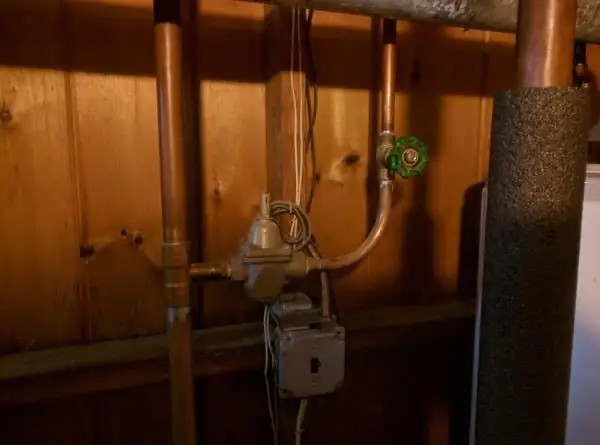2026 Author: Howard Calhoun | [email protected]. Last modified: 2025-01-24 13:10:41
The sewer system, like any other, is composed of different elements that are designed to ensure the most efficient operation. These include manholes, which are necessary for maintenance and monitoring of the state of the system. The arrangement of manholes is required when changing the slope of the collectors, the diameter of the pipes and their direction.
Varieties of manholes

Inspection wells, depending on the design features, may belong to one of the types. Among them it is necessary to distinguish: linear, rotary, nodal, control, washing, differential, as well as those that have enlarged hatch dimensions. Linear are located on straight sections, rotary are used in those places where the sewer line changes its direction. The nodal well is located in those places where several branches are connected. Such a node can have no more than three inlet and one outlet pipe. If we are talking about a large collector, then the design is called the connecting chamber. Control wells should be equipped in those places whereconnection of the yard, factory, as well as the intra-quarter network to the street. Wash wells are located in primary areas where sedimentation is possible due to low velocity. Their need arises when flushing of pipes is required.
Design

Manholes may be of a certain type, but generally have similar design features. They include the following elements: neck, tray, hatch, working chamber and base. They can be made from different materials, namely: plastic, reinforced concrete blocks, brick or stone. If the well is located on an area without a pavement, then around the construction of a blind area is required, it is necessary for effective water drainage. Inspection wells in terms of most often have the shape of a rectangle or circle. The base is made of reinforced concrete slabs, which are mounted on a crushed stone pillow. In the design, the pipeline passes into the tray, which is the main technological part. It is necessary for the movement of wastewater. Its total height should not be less than the diameter of the larger pipe. It is made of monolithic concrete using templates. Shelves are mounted on both sides of the tray, on which work surfaces are located. These elements should have a slight slope towards the tray.
What else you need to know about the design features of the manhole

Viewpointssewerage wells are equipped with ladders and brackets for descent. And their height is most often equal to 1800 millimeters, the diameter must correspond to the diameter of the pipe. The neck, as a rule, has a standard size, which is 700 millimeters. The manhole hatch should be located at a height ranging from 70 to 200 millimeters above the ground. This element plays the role of protecting the camera from clogging. It protects people from accidents. As a material for the hatch, cast iron can be used, as well as polymeric materials, the latter of which are distinguished by strength, durability and lightness. Cast iron hatches, although more massive, are indispensable for laying on the roadway, where they will be subjected to heavy loads.
Manhole characteristics

Previously, wells were made of reinforced concrete and brick, but today plastic wells are increasingly used, which have the qualities of high rigidity. In the West, this technology has been practiced for a very long time. The low frost resistance of this material did not add popularity to these products in Russia for some time, but today modern plastics are suitable for the most severe climate. Structures made of plastic do not differ from reinforced concrete in almost anything. The structure has a base, a telescopic cover and a shaft pipe. Manhole rings are sometimes present, as well as a manhole and a slab. Plastic systems have many advantages over reinforced concrete systems, as they have exhaust holes in their base that are adjusted to the dimensions.sewer pipes. If we are talking about reinforced concrete systems, then they require changes in the holes for pipes and their formation, which involves time and financial costs.
Despite the fact that plastic wells seem quite fragile, reliability can be distinguished among their characteristics, because such products are capable of undergoing high pressure. If, considering one of the elements of the sewer, you find the marking 3634 99 - the manholes of the manholes are in front of you. They may have special storm water inlets, each of which belongs to its own load class. The following classes are most common: class B, which is capable of enduring a load of up to 12.5 tons, and class D, it can withstand up to 40 tons of load during operation.
Characteristics of plastic drainage manholes

Drainage inspection well made of plastic has recently been increasingly purchased by customers. This is due to the fact that it can be used at a fairly wide temperature range from -25 to +45 degrees. The inner surface of the pipe is smooth for easy cleaning. Drainage wells are used to connect drainage pipelines and then collect drainage water. The height of the rod pipe and the number of outlets can be selected individually by the consumer, everything will depend on the terrain. Such structures are ready to serve for more than 50 years, and they are based on polypropylene pipes. Manhole pipes have outlet diameters ranging from 63 to 200millimeters, while the diameter of the rod pipe is standard and is 315 millimeters.
Distance between linear manholes

The distance between linear manholes will depend on the diameter of the pipe. Thus, if the diameter is 50 millimeters, then the distance is 35 millimeters. If the diameter is more than 2000 millimeters, then the step between the wells should be 300 meters. With an average value ranging from 700 to 900 millimeters, the wells should be removed from each other by a distance of 100 millimeters.
Depth of the manhole sewer pipes

Installation of a sewer manhole must be completed with the installation of sewer pipes. The depth of their laying can vary from 30 to 40 centimeters, but it is important to take into account the slope of the pipe in the ground, it should be one centimeter per meter of the route. You should not get carried away with the slope either, since the entry into the well should be higher, which will contribute to the minimum loss of volumes. Do not forget about the waterproofing of sewer wells. When digging a trench, you should not dig too deep, even if you plan to add earth under the pipe. It is best to leave a small margin, as the sprinkled soil can sag over time, which will cause the slope of the track to lose. It is forbidden to put objects under the track, as they can damage the pipe.
Conclusion
Don't give upthe purchase of plastic elements in favor of reinforced concrete before arranging manholes, since they are absolutely tight, can be laid quite simply compared to heavy counterparts, and also have a low cost. During installation, the use of special equipment is not required, as well as during loading and unloading, you can even carry out these works without outside help. Such elements are easy to operate, as they do not require frequent cleaning. Environmentally friendly materials are used in the process of their manufacture.
Recommended:
SRO approval in design. Self-regulatory organization in the field of architectural and construction design. Non-Profit Organizations

Specialists in various fields, start-up and existing entrepreneurs, as well as civil servants will definitely face such a definition as SRO. What is it and how is it related to construction and design? You can find out more in this article
Diesel locomotive 2TE10M: design and characteristics

The constant growth of industry in the USSR in the 70s led to an increase in freight traffic. The locomotives available in the depot fleet could not move large trains at high speeds and on roads with difficult terrain. The development of diesel locomotives with diesel power from 4000 forces was not included in the long-term plans of diesel locomotive enterprises, so the emphasis was on the creation of multi-section locomotives made up of standard serial parts
Characteristics of the Su-35. Su-35 aircraft: specifications, photo of the fighter. Comparative characteristics of the Su-35 and F-22

In 2003, the Sukhoi Design Bureau began the second in line modernization of the Su-27 fighter to create the Su-35 aircraft. The characteristics achieved in the process of modernization make it possible to call it a 4++ generation fighter, which means that its capabilities are as close as possible to the PAK FA fifth generation aircraft
Low pressure heaters: definition, principle of operation, technical characteristics, classification, design, operation features, application in industry

Low pressure heaters (LPH) are currently used quite actively. There are two main types that are produced by different assembly plants. Naturally, they also differ in their performance characteristics
RPSh cable: purpose, design, installation, characteristics and decoding

This article will contain information about RPSh type cables - its technical characteristics, marking definition and its decoding

